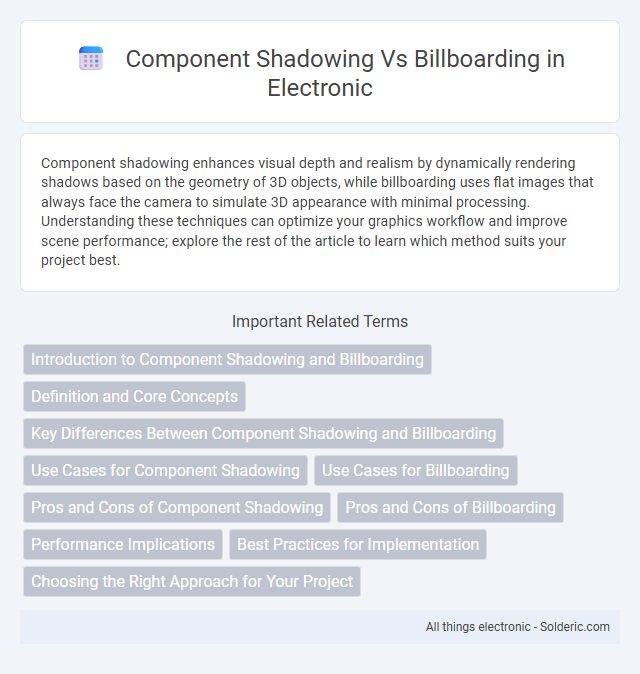Component shadowing enhances visual depth and realism by dynamically rendering shadows based on the geometry of 3D objects, while billboarding uses flat images that always face the camera to simulate 3D appearance with minimal processing. Understanding these techniques can optimize your graphics workflow and improve scene performance; explore the rest of the article to learn which method suits your project best.
Comparison Table
| Feature | Component Shadowing | Billboarding |
|---|---|---|
| Definition | Overriding specific UI components without altering the core code. | Rendering 2D objects always facing the camera for 3D illusion. |
| Purpose | Customizing behavior or style in component-based frameworks. | Enhancing 3D scenes with flat objects that simulate depth. |
| Use Case | Modifying UI components in CMS like Gatsby or React frameworks. | Displaying sprites, labels, or effects in 3D environments. |
| Implementation | Creating local copies of components to customize and override. | Automatically rotating objects to face the camera view in real-time. |
| Impact on Performance | Minimal; only specific components overridden. | Can be costly with many billboards due to rotation calculations. |
| Rendering Type | UI/UX rendering in web applications. | 3D graphics and game rendering engines. |
Introduction to Component Shadowing and Billboarding
Component shadowing enhances 3D graphics by dynamically casting realistic shadows on objects, improving depth perception and visual realism in digital environments. Billboarding involves orienting objects, typically 2D sprites, to always face the camera, optimizing rendering efficiency and maintaining consistent visibility regardless of the viewer's perspective. Understanding these techniques helps you choose the appropriate method for balancing graphical fidelity and performance in your projects.
Definition and Core Concepts
Component shadowing refers to a technique in 3D graphics where specific parts of an object cast shadows based on lighting conditions, enhancing realism by accurately simulating light interactions on detailed surfaces. Billboarding involves rendering a 2D object, such as a sprite, that always faces the camera regardless of the viewer's angle, commonly used to create the illusion of 3D in games or simulations with lower computational cost. Understanding these concepts helps you optimize visual effects by choosing between realistic shadow casting or simplified object orientation for performance efficiency.
Key Differences Between Component Shadowing and Billboarding
Component shadowing creates realistic shadows by simulating light interaction with 3D elements, enhancing depth and spatial perception. Billboarding involves rotating a flat 2D object to always face the camera, maintaining consistent visual orientation without complex lighting calculations. Understanding these techniques helps you choose shadowing methods that either improve visual realism or optimize performance in 3D environments.
Use Cases for Component Shadowing
Component shadowing is primarily used in web development frameworks like Astro to customize or override default components without altering the original source, enabling developers to tailor UI elements for specific page contexts or themes. This technique enhances maintainability and scalability by isolating modifications, making it ideal for projects with shared components across multiple pages or applications that require consistent yet adaptable design systems. Use cases include theming, localization, and injecting custom behavior into third-party components while preserving core functionality.
Use Cases for Billboarding
Billboarding is commonly used in 3D graphics and game development to create sprites or objects that always face the camera, enhancing visual clarity for objects like trees, particles, and UI elements. This technique optimizes rendering performance by using 2D textures on flat planes instead of fully modeled 3D objects, ideal for distant or numerous assets. Billboarding is essential for maintaining consistent user experience in VR environments, where perspective and orientation significantly impact immersion.
Pros and Cons of Component Shadowing
Component shadowing enhances 3D model realism by accurately representing shadows based on object geometry, improving visual depth and immersion. However, it demands higher computational resources, potentially reducing performance on lower-end devices and increasing rendering times. You must balance the visual quality gains with the system performance impact when deciding to implement component shadowing in your project.
Pros and Cons of Billboarding
Billboarding offers the advantage of maintaining consistent visual orientation toward the camera, which simplifies rendering and improves performance in 3D environments by reducing polygon counts. However, this technique can lead to visual artifacts such as noticeable flatness or unrealistic depth perception when viewed from different angles. Your choice to use billboarding should balance performance gains with potential compromises in visual fidelity depending on the application's requirements.
Performance Implications
Component shadowing improves rendering quality by allowing detailed and accurate shadow effects but can significantly increase GPU workload and reduce frame rates in complex scenes. Billboarding simplifies shadows by using flat, camera-facing textures that drastically lower computational costs and memory usage, enhancing real-time performance, especially in large-scale environments. Choosing between these impacts depends on balancing visual fidelity against processing limitations, with billboarding favored in resource-constrained or real-time applications.
Best Practices for Implementation
Component shadowing ensures enhanced realism by accurately rendering shadows that respond dynamically to lighting conditions, while billboarding optimizes performance by displaying simplified 2D sprites facing the camera. Best practices for implementation include using component shadowing for critical, interactive objects to maintain visual fidelity and leveraging billboarding for distant or non-interactive elements to reduce computational load. Your choice should balance visual quality with system performance, applying shadowing selectively and integrating billboarding where real-time shadows are unnecessary.
Choosing the Right Approach for Your Project
Choosing between component shadowing and billboarding depends on the project's visual goals and performance requirements. Component shadowing offers realistic depth and lighting effects beneficial for detailed 3D environments, while billboarding provides a performance-friendly solution by displaying 2D sprites that always face the camera, ideal for large crowds or distant objects. Assessing factors like rendering budget, scene complexity, and desired visual fidelity guides the optimal approach for achieving immersive and efficient graphics.
Component shadowing vs billboarding Infographic

 solderic.com
solderic.com